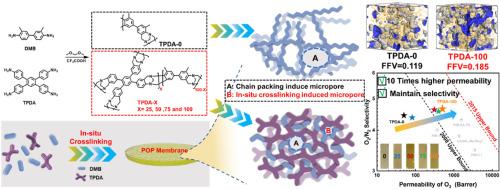多孔有机聚合物膜衍生自鼠胺为基础Tröger的基础,同时提高了渗透性和选择性
IF 9
1区 工程技术
Q1 ENGINEERING, CHEMICAL
引用次数: 0
摘要
结合固有微孔聚合物(PIM)和多孔有机聚合物(POP)的优点,是实现高效气体分离膜的一种很有前途的方法。在这项研究中,我们成功地合成了一系列由高度交联的Tröger's碱(TB)衍生的新型POP膜,以3,3 ' -二甲基联苯-4,4 ' -二胺为线性部分,以4,5-双(4-氨基苯基)-[1,1:2,1-terphenyl]-4,4-二胺(TPDA)为交联剂,包含四个节点。所得的POP网络膜的链间距从7.96减小到5.76 Å,比表面积从250显著增加到534 m2 g−1,超微孔隙度从TPDA-0显著提高到TPDA-100。与线性TPDA-0相比,交联膜的透气性和气体对选择性显著提高。例如,与线性TPDA-0相比,TPDA-100的O2渗透率(507 Barrer vs. 50.3 Barrer)提高了约10倍,O2/N2选择性(4.7 vs. 4.5)也有所提高。随着TPDA含量的增加,O2/N2、H2/N2和H2/CH4的整体气体分离性能从远低于Robeson上限逐渐提高到超过Robeson上限。这些增强是由于原位交联POP结构产生了更高的超微孔隙体积和浓度。这种直接合成策略为开发高性能气体分离膜材料提供了一种有前途的可扩展策略。本文章由计算机程序翻译,如有差异,请以英文原文为准。

Porous organic polymer membranes derived from tetramine-based Tröger's base with simultaneously enhanced permeability and selectivity
Combining the advantages of polymers of intrinsic microporosity (PIM) and porous organic polymer (POP) is a very promising method for achieving high-efficiency gas separation membranes. In this study, we successfully synthesized a series of novel POP membranes derived from a highly crosslinked Tröger's base (TB), using 3,3′-dimethylbiphenyl-4,4′-diamine as a linear part and 4,5-bis(4-aminophenyl)-[1,1:2,1-terphenyl]-4,4-diamine (TPDA) as crosslinker that contains four nodes. The resulting POP network membranes showed reduced interchain spacing from 7.96 to 5.76 Å, significantly increased Brunauer-Emmett-Teller (BET) surface area from 250 to 534 m2 g−1, and markedly enhanced ultramicroporosity from TPDA-0 to TPDA-100. Compared to the linear TPDA-0, the crosslinked membranes demonstrated marked improvement in gas permeability and gas pair selectivity. For example, the TPDA-100 exhibited ∼10 times higher O2 permeability (507 vs. 50.3 Barrer) along with an improved O2/N2 selectivity (4.7 vs. 4.5) compared to the linear TPDA-0. With the increasing of TPDA content, the overall gas separation performance gradually increased from far below to surpass the 2008 Robeson Upper bound limits for O2/N2, H2/N2, and H2/CH4. These enhancements are attributed to the higher ultramicroporosity volume and concentration originated from the in-situ crosslinked POP structure. This direct synthesis strategy provides a promising and scalable strategy for developing high-performance gas separation membrane materials.
求助全文
通过发布文献求助,成功后即可免费获取论文全文。
去求助
来源期刊

Journal of Membrane Science
工程技术-高分子科学
CiteScore
17.10
自引率
17.90%
发文量
1031
审稿时长
2.5 months
期刊介绍:
The Journal of Membrane Science is a publication that focuses on membrane systems and is aimed at academic and industrial chemists, chemical engineers, materials scientists, and membranologists. It publishes original research and reviews on various aspects of membrane transport, membrane formation/structure, fouling, module/process design, and processes/applications. The journal primarily focuses on the structure, function, and performance of non-biological membranes but also includes papers that relate to biological membranes. The Journal of Membrane Science publishes Full Text Papers, State-of-the-Art Reviews, Letters to the Editor, and Perspectives.
 求助内容:
求助内容: 应助结果提醒方式:
应助结果提醒方式:


